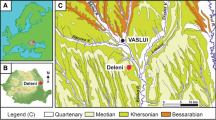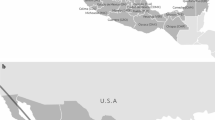Abstract
Radon activity concentrations of 1077 homes were surveyed in two villages of Northern Hungary to obtain the yearly averages. The distribution of indoor radon activity concentrations covered a wide range. Cancer incidences of all the 2680 inhabitants for the last 30 years were also studied in these villages in order to establish a possible correlation with radon exposure. The methods applied in the analysis allow to draw up statistically supported statements concerning the relative cancer risks of different radon level groups. The results show that among non-smoking middle-aged women the frequency of cancer, regardless to tumor types, is lower for those who live in residential radon activity concentrations of a level between 110 and 185 Bq.m-3 compared to those living in radon levels outside this range. A minimum value in the cancer frequency exists at a level of significance p<0.008 (determined with the help of Fisher's test). In general, the present study corroborates the outcome of other studies demonstrating the existence of a biopositive effect, and suggests a wider concept of radon health effects.
Similar content being viewed by others
References
W. J. Blot, Z. Y. Xu, J. D. Boice et al., J. Natl. Cancer Inst., 82 (1990) 1025.
K. T. Bogen, D. W. Layton, Human Exp. Toxicol., 17 (1998) 463.
B. L. Cohen, Environ. Res., 53 (1990) 193.
B. L. Cohen, Health Phys., 68 (1995) 157.
A. Czeizel, H.-G. Beakmann, H. W. Goedde, Genetics of the Hungarian Population, Vol. 3, Springer, Berlin, 1991, p. 319.
P. Duport, D. Krewski, X. Luo, J. Zielinski, Cancer Risk at Low Doses and Dose Rates of Ionizing Radiation in Animals, Proc. of IRPA 10th Intern. Congress of The International Radiation Protection Association, Hiroshima, Japan, 2000.
L. E. Feinendegen, Human Exper. Toxic., 21 (2002) 85.
L. I. Havlicek, R. D. Crain, Practical Statistics for the Physical Sciences, American Chemical Society, Washington, DC, 1988.
R. M. Haynes, Radiat. Prot. Dosim., 25 (1988) 93.
HCSO, Cancer mortality statistics, Report of the Hungarian Central Statistical Office, 2002.
ICRP, Protection Against Radon-222 at Home and at Work. ICRP Publication 65. A report of a Task Group of the International Commission on Radiological Protection, 1993.
K. Kant, R. P. Chauhan, G. S. Sharma, S. K. Chakravarti, On the Evidence of Radiation Hormesis in Humans Exposed to Low-Level Ionizing Radiation, Abstract Book of the 2nd Intern. Conf. of World Council of Nuclear Workers, The Effects of Low and Very Low Doses of Ionizing Radiation on Human Health, Dublin, Ireland, 2001.
G. J. KÖteles, Central European J. Occup. Environ. Med., 4/2 (1998) 103.
H. P. Leenhouts, M. J. P. Brugmans, Radiat. Environ. Biophys., 40 (2001) 11.
J. H. Lubin, J. D. Boice Jr., J. Natl. Cancer Inst., 89 (1997) 49.
T. D. Luckey, Intern. J. Occup. Med. Toxicol., 3/2 (1994) 73.
T. D. Luckey, Low Dose Irradiation Reduces Cancer Mortality Rates. Proc. of IRPA 10th Intern. Congress of The International Radiation Protection Association, Hiroshima, Japan, 2000.
W. Luxin, J. Radiat. Res., 31 (1990) 119.
M. Mifune, T. Sobue, H. Arimoto et al., Japan J. Cancer Res., 83 (1992) 1.
S. M. J. Mortazavi, M. Ghiassi-nejad, P. A. Karam, T. Ikushima, A. Niroomand-rad, J. R. Cameron, Cancer Incidence in Areas with Elevated Levels of Natural Radiation, Abstract Book of 2nd Intern. Conf. of World Council of Nuclear Workers, The Effects of Low and Very Low Doses of Ionizing Radiation on Human Health, Dublin, Ireland, 2001.
K. S. V. Nambi, S. D. Soman, Health Phys., 52 (1987) 653.
G. Pershagen, G. Akerblom, O. Axelson et al., New Engl. J. Med., 330 (1994) 159.
M. Pollycove, L. E. Feinendegen, C. R. Acad. Sci. Paris, Sciences de la vie/Life Sciences, 322 (1999) 197.
M. Pollycove, L. E. Feinendegen, Molecular Biology, Epidemiology and Radiation Protection, Abstract Book of 2nd Intern. Conf. of World Council of Nuclear Workers, The Effects of Low and Very Low Doses of Ionizing Radiation on Human Health, Dublin, Ireland, 2001.
E. TÓth, High Radon Activity in North-East Hungary. Physica Scripta, 50/6 (1994) 726.
E. TÓth, F. DeÁk, Cs. GyurkÓcza, Zs. Kasztovszky, R. Kuczi, G. Marx et al., Environ. Geol. 31/1-2 (1997) 123.
E. TÓth, I. LÁzÁr, D. Selmeczi, G. Marx, Pathol. Oncol. Res., 4/2 (1998) 125.
UNSCEAR, Sources and Effects of Ionizing Radiation, UNSCEAR 2000 Report to the General Assembly, with Scientific Annexes, United Nations Scientific Committee on the Effects of Atomic Radiation, 2000.
W. Ye, T. Sobue, V. S. Lee, Japan J. Cancer Res., 89 (1998) No. 8, 789.
Author information
Authors and Affiliations
Rights and permissions
About this article
Cite this article
Lázár, I., Tóth, E., Marx, G. et al. Effects of residential radon on cancer incidence. Journal of Radioanalytical and Nuclear Chemistry 258, 519–524 (2003). https://doi.org/10.1023/B:JRNC.0000011745.88739.53
Issue Date:
DOI: https://doi.org/10.1023/B:JRNC.0000011745.88739.53




